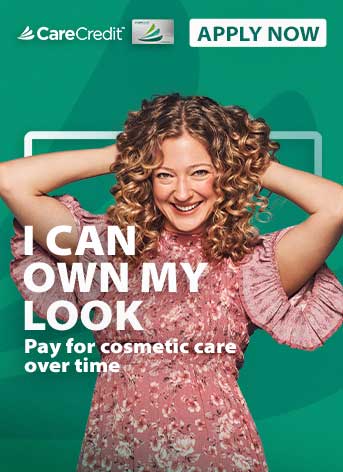Collagen and elastin are two proteins responsible for keeping our skin firm and smooth. As we age, we produce less collagen and elastin, which often results in sagging, crepey skin on the face, neck and other areas of the body. Non-surgical skin tightening can temporarily restore firmer, younger-looking skin by stimulating the production of collagen and elastin, usually with little to no downtime.1
What Is Non-Surgical Skin Tightening?
Non-surgical skin tightening procedures use non-invasive devices to target heat energy into the deeper layers of the skin, causing existing collagen fibers to contract or tighten. The heat also stimulates the body's healing process to produce a new collagen foundation, gradually improving the tone, texture and firmness of moderately lax or sagging skin. Some non-surgical skin tightening treatments also target fibrous tissue to help smooth cellulite.2
FDA-approved skin tightening treatments generally use laser, radiofrequency or ultrasound energies to deliver heat to the sublayers of skin tissue. Treatments can be applied to the following areas of the body:
- Face
- Neck
- Abdomen
- Buttocks
- Arms
- Thighs
The number of treatments needed will vary based on the technique, patient needs and desired results.2
Benefits (and Limits) of Non-Surgical Skin Tightening
Non-surgical skin tightening procedures can be a good option for patients who want to alter the look of their face, neck, arms, abdomen, buttocks or thighs but wish to avoid invasive cosmetic surgery such as facelift, tummy tuck or liposuction.3
Benefits of non-surgical skin tightening:1
- Treatments tone mild to moderately loose skin on the face, neck or body without surgery or scars.
- Most treatments can be performed in-office, often in one hour or less.
- There is a low risk of adverse effects when performed by a qualified provider.
- Little to no downtime for recovery is needed.
- Results can last for up to one year or longer, depending on the treatment.
- Procedures are typically less expensive than surgical options.
Limits of non-surgical skin tightening:1
- Results appear gradually over weeks or months.
- Treatments often must be repeated to maintain results.
- Treatments are not an effective option for advanced skin laxity due to age, pregnancy or weight loss.
Are You a Good Candidate for Non-Surgical Skin Tightening?
With few risks or side effects associated with non-surgical skin tightening, most procedures are generally suitable for patients who are in good health, and have a thorough understanding of their treatment plan and realistic expectations.
Non-surgical skin tightening may not be appropriate for patients who are pregnant, have an infection in the area to be treated, or have issues with blood clotting or other medical conditions.
Consult your doctor and a cosmetic surgeon to find out if a non-surgical skin tightening procedure could be right for you.1
Non-Surgical Skin Tightening Treatments
Ultrasound (Ultherapy®)1
Sometimes described as a “mini facelift" and often used as a preventative against skin laxity, ultrasound skin tightening heats the skin up to 5mm deep to stimulate collagen production on the brow, chin, chest and neck. Treatments are delivered by FDA-approved handheld devices and use ultrasound imaging to target the exact layers of skin where treatment will be most effective.
- In-office treatments can last 60 to 90 minutes.
- Possible mild side effects include temporary redness, numbness or swelling.
- Results are visible within two to three months and may last up to a year.
Radiofrequency (Thermage®, Profound® RF, Exilis®, Morpheus8®)3
Radiofrequency (RF) uses an FDA-approved device to apply RF energy to heat the skin and trigger collagen production in the epidermal layers on the face, neck, hands and body.
- In-office treatments can be done with little discomfort and involve no downtime.
- Results are gradual, appearing within two to four months.
- Multiple treatments may be required to see optimal results.
Combined Intense Pulsed Light (IPL) and Radiofrequency (Velashape®, Venus Versa®)1
Radiofrequency (RF) delivers heat deep into the dermal layers of the skin to stimulate collagen production for a skin-tightening effect, while intense pulsed light therapy (IPL) uses wavelengths of light energy to improve the color and texture of the skin caused by sun damage on the face, neck, hands or chest. IPL may also help reduce the appearance of other skin conditions including acne, rosacea, age spots, birthmarks or stretch marks.4
- Combination treatments are an efficient way to treat multiple skin conditions simultaneously.
- In-office treatment performed with little to no discomfort or downtime.
- Effects appear gradually and may require multiple treatments for maximum effect.
- IPL may not be effective on dark or tanned skin.
Laser resurfacing (SkinTyte®)
Non-ablative skin resurfacing uses a laser to treat wrinkles, scars and age spots. Non-ablative lasers are typically fractionated to administer hyper-targeted heat through thousands of tiny columns called microthermal treatment zones, which allows the skin to heal faster.5
- In-office treatment has little to no downtime.
- Effects are gradual, appearing over several months.
- Multiple treatments may be necessary for optimal results.
Thread Lift (NovaThreads®, Silhouette InstaLift®)
A thread lift is a non-surgical procedure in which your provider uses temporary sutures to produce a natural "lift" in the skin. A thread lift also stimulates the body's natural healing response causing the body to increase collagen production in the treated areas of the face.6
- In-office procedures may be performed under a local anesthetic.
- Patients may experience some soreness or swelling, though most can return to work the following day.
- Results can last from one to three years.
Non-Surgical Skin Tightening by Body Part
Not all FDA-approved non-surgical skin tightening techniques are approved for every part of the body. Here is a listing of which procedures are intended for different areas of the body.
Ultrasound therapy, laser resurfacing and thread lifts have been approved for areas of the face including the brow, chin, neck, jaw and the décolletage (chest).
Radiofrequency and combination RF/IPL treatments are also approved for use on areas of the face, neck and chest, but may also be used on the stomach, legs and arms as RF/IPL are able to cover a larger surface area with better results.1
Costs of Non-Surgical Skin Tightening Treatments
Individual patient costs for non-surgical skin tightening procedures will vary based on:3
- Geographic location
- Experience of the provider
- Type of procedure being performed
- Area(s) of the body on which the procedure is being performed
- Number of treatments required for optimal results
Consult your provider for a thorough understanding of a treatment plan that's right for you.
Ultrasound therapy cost
The average cost of ultrasound therapy, such as Ultherapy®, is $2,265 but can range up to $4,175 based on the number of treatments and any treatment areas in addition to the face such as the neck or décolletage.7
Radiofrequency therapy cost
Pricing will range from $1,000 to $4,000 for one to five treatments based on which part of the body is being treated, and how many treatments are needed. For example, average pricing may be $1,300 for the eyes, $2,000 for the face and $3,000 to $4,000 to include the tummy or buttocks.8
Combined RF/IPL therapy cost
IPL treatments can average between $700 to $1,200, combined with the additional cost of RF treatments which may average $1,000 to $4,000 for one to five treatments.8
Laser resurfacing cost
Non-ablative laser skin resurfacing treatment averages between $1,445 to $2,225.9
Thread lift cost
A thread lift such as NovaThreads® or Silhouette InstaLift® costs on average $2,025 but can range as much as $5,500 based on the areas of the face, brow, neck, jowls or jawline being treated.10
Non-surgical skin tightening options can be a good alternative to surgery, with less expense and minimal recovery time. Work with the provider to help you set realistic expectations and explore which options might be right for you.
CareCredit Financing for Non-Surgical Skin Tightening
When getting a skin tightening procedure or another cosmetic procedure, the CareCredit credit card can help you pay for costs not covered by insurance.* Apply today and use our Acceptance Locator to find a doctor or cosmetic specialist near you that accepts CareCredit. Continue your wellness journey by downloading the CareCredit Mobile App to manage your CareCredit account, find a provider on the go, and easily access the Well U hub for more great articles, podcasts, and videos.
Author Bio
Anne-Marie Kennedy is a freelance writer with more than 20 years of experience covering health and wellness, personal finance, and real estate/investing.








